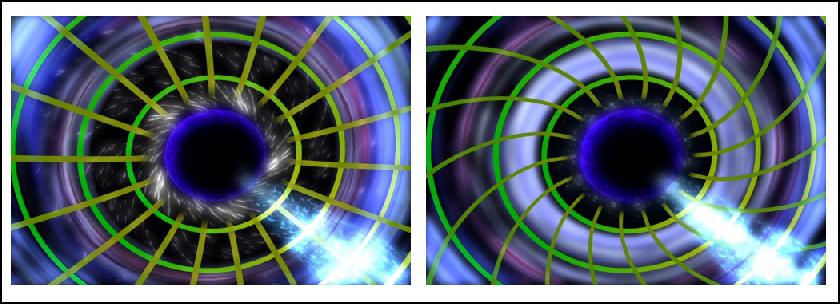
 Credit: NASA/HONEYWELL MAX-Q DIGITAL GROUP/DANA BERRY
Credit: NASA/HONEYWELL MAX-Q DIGITAL GROUP/DANA BERRY
Everything Spins
Spin is a characteristic of nearly every piece of matter, from the smallest
sub-atomic particle to the largest galaxy. Spin (or more properly, angular
momentum) is conserved, so that as the size of a rotating object
decreases, its spin rate increases. The formation of a black hole
represents the ultimate shrinking of matter, in which matter collapses to
occupy no space. Conservation of angular momemtum suggests that black holes
should spin, but what this "spin" would represent is hard to understand,
since it's impossible to see inside the black hole's "event
horizon". So how can the spin of a black hole be measured? A team of
astronomers at the NASA/Goddard Space Flight Center think they've found one
way to measure the spin of a black hole, by measuring the effect of the
black hole's spin on the surrounding space. According to Einstein's theory
of general relativity, a spinning black hole should drag spacetime around
(so that should an astronaut come near a spinning black hole, she'd start
spinning too!). The image above represents the space-time around a
non-spinning black hole (left) and spinning black hole (right). Using the
Rossi X-ray Timing Explorer (RXTE),
these astronomers believe they've detected a signal from matter rotating
with the black hole in the star system known as GRO J1655-40. "A spinning
black hole modifies the fabric of spacetime near it," said Dr. Tod
Strohmayer of GSFC, who lead the team which analyzed the RXTE data. "The
spinning allows matter to orbit at a closer distance than if it were not
spinning, and the closer matter can get the faster it can orbit."
Strohmayer and his colleagues detected a signal from this innermost,
fastest-moving material orbiting with the spinning black hole.
Last Week *
HEA Dictionary * Archive
* Search HEAPOW
* Education
Each week the HEASARC
brings you new, exciting and beautiful images from X-ray and Gamma ray
astronomy. Check back each week and be sure to check out the HEAPOW archive!
Page Author: Dr. Michael F.
Corcoran
Last modified May 14, 2001


